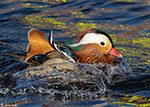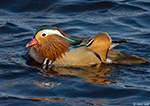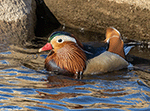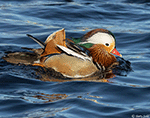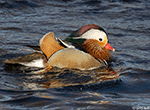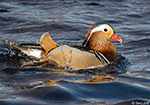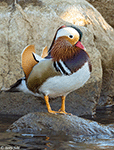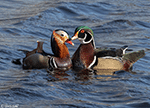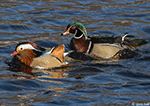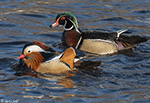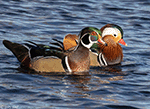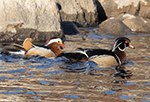| Length: 16-18 inches | Wingspan: 26 to 28 inches | Seasonality: Vagrant/Escapee in South Dakota |
| ID Keys: Male unmistakable, with red bill, "whisker" feathers", white upper face and boldly colored plumage. Females could be confused with female Wood Duck. | ||
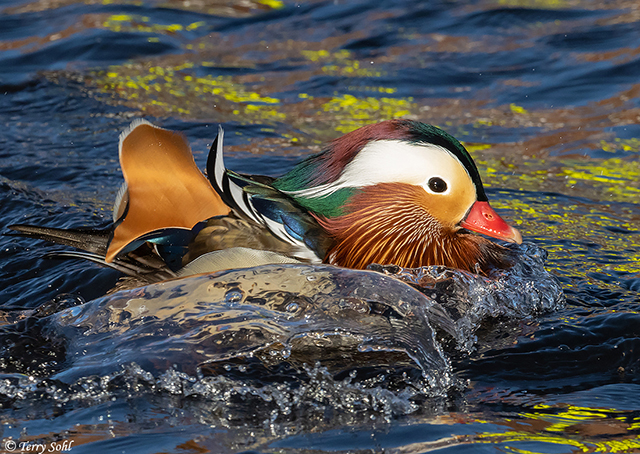 The
Mandarin Duck is an extremely colorful small dabbling duck with a native range
in eastern Asia, including most of the Japanese Islands, eastern China, and
southeast Asia. There they are birds of woodland and forest lakes, using nesting
cavities in the trees for breeding while foraging in nearby lakes and rivers.
The
Mandarin Duck is an extremely colorful small dabbling duck with a native range
in eastern Asia, including most of the Japanese Islands, eastern China, and
southeast Asia. There they are birds of woodland and forest lakes, using nesting
cavities in the trees for breeding while foraging in nearby lakes and rivers.
With their unique, colorful plumage, Mandarin Ducks have sometimes been popular birds to raise in captivity. Escapees have established strong, permanent breeding populations in parts of western Europe. Similarly, there are now small permanent, free-flying and reproducing populations in parts of the United States, particularly in California.
Despite the establishment of breeding populations in parts of the US, sightings of the species in most of the US are generally considered to be of escaped birds, although free-flying and wild birds cannot be completely discounted. In South Dakota, a lone male Mandarin Duck was found in a small urban park in Yankton in the fall of 2020 (photo to the right and those below). Likely one of the most seen and photographed individual birds to ever be seen in South Dakota, the colorful drake spent several weeks at the park, in the companionship of a male Wood Duck. The two were inseparable, following each other and even defending territory from other waterfowl on the park's small pond. Unfortunately, the Mandarin Duck disappeared in December 2020, with feathered remains near the pond suggesting it was captured by a predator.
Habitat:
In its native habitat in eastern Asia, Mandarin Ducks prefer woodland and forest edges adjacent to water bodies, with access to both nesting cavities for breeding, and foraging areas in the adjacent aquatic habitat. Introduced and feral populations in western Europe and North America are more likely to use more open marshland and wetland habitats than their counterparts in eastern Asia.
They are found in freshwater habitats during the summer breeding season, but will also use protected coastal marshes and bays during the winter months.
Diet:
Omnivorous, eating a wide variety of food items, but with vegetative material often making up the majority of the diet. The diet may include seeds, plant shoots and roots, insects, small crustaceans and mollusks, and occasionally small fish or amphibians.
Behavior:
Foraging primarily occurs early or late in the day, with daylight hours used to roost in a tree or in a semi-protected location on the ground near water. Foraging is done by dabbling from the water's surface, or by walking on the shoreline near water.
Nesting:
Like their North American relatives the Wood Duck, Mandarin Ducks are cavity nesters, selecting a natural cavity (or cavity made by another creature) in a tree close to water. The female lays between 8 and 12 eggs, and she alone incubates the eggs. The male generally departs before the eggs hatch, leaving the female to tend to the young. Incubation lasts about 4 weeks, with the young leaving the nest within a day of hatching. The female leads the young to water and protects them, but the young feed themselves. The young won't gain flight ability for several weeks after hatching.
Song:
Male Mandarin Ducks have a thin, repeated rising whistling call. Females have multiple short (and often harsh) call notes. Flight and alarm calls are a repeated, loud series of ku-whack notes.
1Click here to hear the whistling calls of a male Mandarin Duck
2Click here to hear flight calls of a flushed Mandarin Duck
3Click here to hear a short, harsh call of a female Mandarin Duck
Migration:
Generally considered to be permanent residents in much of their normal range in eastern Asia. However, they will sometimes gather in larger flocks in the winter months, even eschewing their normal freshwater habitats for coastal saltwater habitats.
Interactive eBird map:
Click here to access an interactive eBird map of Mandarin Duck sightings
Similar Species:
Males are unmistakable and unlikely to be confused with any other species. Female Mandarin Ducks share similarities with female Wood Ducks.
Conservation Status:
Populations of Mandarin Duck in their native range in east Asia have undoubtedly declined in the 20th and 21st centuries. However, they are still found in a relatively broad geographic area and are common in parts of their range. They also have growing established populations in western Europe, and some small populations established in North America. Thus, despite the declines, overall numbers are strong enough that the IUCN considers the Mandarin Duck to be a species of "Least Concern".
Further Information:
3) Seaworld.org - Mandarin Duck
Photo Information:
November 15th, 2020 -- Yankton, South Dakota -- Terry L. Sohl
Additional Photos:
Click on the image chips or text links below for additional, higher-resolution Mandarin Duck photos. Note that many of the photos below include an odd couple from Yankton, South Dakota, in the late fall of 2020, when a Mandarin Duck and Wood Duck drake were found hanging out together for several weeks.
Audio File Credits:
1Ireneusz Oleksik - April 15th, 2019, from Park Polnocny (near Tychy), Poland - Original file and information available from xeno-canto.
2Huw Lloyd. March 29th, 2020, from Hatchmore in the United Kingdom - Original file and information available from xeno-canto.
3Jarek Matusiak. October 15th, 2017, from Warszawa in Poland - Original file and information available from xeno-canto.
| Click on the range map for a higher-resolution view |
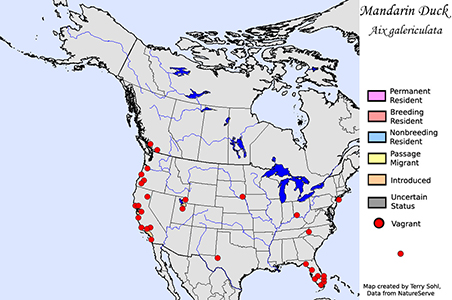 |
| South Dakota Status: Mandarin Duck are generally considered as escapees from captivity when sightings are made in the US. However, there are now free flying and reproducing populations in a number of locations across the country. The Yankton, South Dakota sighting in 2020 was most likely an escapee from captivity but a bird of more natural original cannot be completely ruled out. |
Additional Mandarin Duck Photos
Click for a higher-resolution version of these photos
